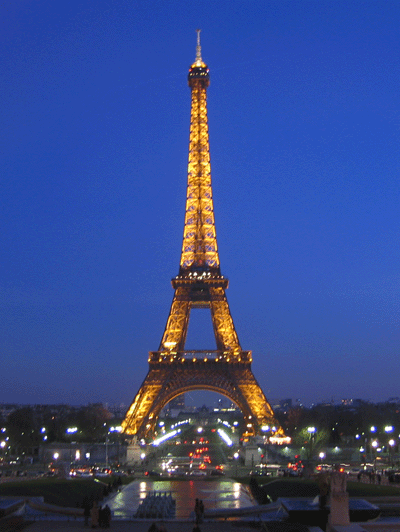The history of Paris lives through its monuments. Tourists from around the world crowd to climb the Tour Eiffel, or visit the military history at the Defense. The Arc de Triomphe is a French landmark, and the Pantheon has such historical tales. We knew we were in Paris to discover the city from the inside, to see what's there besides the tourist-ridden monuments. Still, a few of us couldn't help but see what all the fuss was all about. The monuments we visited all had their own unique and fascinating stories and revealed much to us of the history of the city itself. Here are only a few of the most famous buildings in the world.
La Tour Eiffel
7eme arrondissement.
Metro: Bir-Hakeim (line 6), Ecole-Militaire (line 8)
RER: Champs-de-Mars-Tour-Eiffel (line C)
Located in the 7th arrondissement, the Eiffel Tower can be considered as the most widely known landmark in France; the symbol of Paris.
 |
La Tour Eiffel : View from Théâtre Nationale de Chaillot, after having seen Les Etourdis. |
To the southeast is the Ecole Militaire (French Military School), and to the northwest is the Seine and the Chaillot Palace. Planning began in 1884, construction began in 1887, and the tower was presented in 1889 at the Universal Exposition celebrating the centenary of the French Revolution.
1st Floor: 57m high
2nd Floor: 115m high
3rd Floor: 276m high
One can reach these floors by elevator, or on foot. By the way, they charge you to walk up the stairs, so take the elevator unless you want calves of steel, and buns too.
The tower's architect was Gustave Eiffel (1832-1923).
The tower weighs 10,000 tons, and the top of the tower sways 6-7 cm because of savage gusts of wind.
Evolution of the tower's height:
312.27m (height in 1889, counting the flag at the top)
317.96m (height in 1991, counting the antenna)
318.70m (height in 1994, counting the antenna… must've been a new antenna…)
324.00m (height in 2000, counting the antenna… yet another new antenna…)
The Eiffel tower was actually the tallest building in the world until 1930 when the Chrysler Building in New York was built.
Neat fact: The Eiffel Tower is repainted every 5 years and 50 tons of paint are used each time!
L'Arc de Triomphe + Champs-Elysées
8eme arrondissement.
Metro: Concorde (lines 1, 8, 12), Champs-Elysees-Clemenceau (lines 1, 13), Franklin-D-Roosevelt (lines 1, 9), George-V (line 1), Charles-de-Gaulle-Etoile (lines 1, 2, 6)
RER: Charles-de-Gaulle-Etoile (line A)
Ah, the Champs-Elysées. 71 m wide and 1.9 km long, it is the longest avenue of Paris, finding its starting point at Place de la Concorde and coming to its end at the Arc de Triomphe. Lined with restaurants, cafés, bars, designer boutiques, and nightclubs, it is an avenue that is very much alive and available to all. At 68 Ave. des Champs-Elysées is Guerlain, fine perfumers since 1828, and at 52-60 Ave. des Champs-Elysées you will find one of the many Virgin Megastores, your one stop shop for all things multimedia and electronics related. The Champs-Elysées has been around since 1616, the days of Marie de Médicis (at that time it was a popular avenue known as the Cours de la Reine), but it wasn't until the early 19th century when sidewalks and gas lighting were introduced that the Champs-Elysées began to show a glimmer of what it is today. Not only a site of commercialism, it is a gathering place for the people of France be it riots, demonstrations, or celebrations.
The Arc de Triomphe, as alluded to before, is located at the end of the Champs-Elysées at the center of La Place Charles de Gaulle. The Arc, standing 50 m high and 45 m wide was built from 1806-1836 under the orders of Napoleon Bonaparte following his 1806 victory at Austerlitz. Under the Arc is the Tomb of the Unknown Soldier (a French soldier who sacrificed his life for his country during WWI) and the Eternal Flame which is rekindled every night at 6:30 p.m. and burns to commemorate those who perished during the two world wars.
La Défense
Quartier des Affaires
After spending nearly two weeks living in the Quartier Latin and exploring the older, more central parts of Paris - the Cité, even Montmartre, one gets used to a certain characteristic architecture. Four-storeyed buildings, ornate façades, and grand doors leading to quaint little paved courtyards. All the streets begin to look the same.
La Défense, the Parisian equivalent of downtown, is situated to the north-east of the city, and provides a refreshing contrast to this stereotypical image. It lies at one end of line 1 of the Metro, and is also accessible via RER (Réseau Express Route). The area's most striking feature is the huge glass-and-steel Arc de La Défense, which lies at the end of the Champs-Elysées in the same line as the other two arcs of Paris - L'Arc de Triomphe du Carrousel in the courtyard of the Louvre, and L'Arc de Triomphe de L'Etoile. Beyond lie industrial areas, the vast suburbs that the Parisian mind dismisses as Les Banlieues.
The arch is surrounded by office buildings - skyscrapers à l'américaine housing telecommunications companies and multinational firms. A beautifully lit pool, right next to the metro station, marks the beginning of a long, straight walkway that leads through several examples of contemporary architecture (occasionally reminiscent of MIT's notorious Stata Center) to the foot of the arch. Despite the freshness of the architecture and the obvious care that has gone into planning and design, the area sometime seems curiously devoid of the vibrance that animates Paris. Oh well. We return to our headquarters with another tale to tell.
Le Panthéon
5eme arrondissement.
Aux Grands Hommes La Patrie Reconnaissante
- To Great Men To Whom The Country is Indebted
, reads the front of this imposing Greco-Roman structure. Built in 1755 (and finished in 1789) by the French architect Soufflot, at the request of Louis XV, the Panthéon is situated on La Montagne Ste Geneviève in the Latin Quarter. It houses a crypt where are to be found the tombs of some of France's most illustrious literary figures , such as: Mirabeau, Voltaire, Rousseau, Hugo, Zola, Malraux, or Alexandre Dumas (the last one to have been transferred there, in 2002) as well as political figures such as Marat, Jean Moulin, Jean Jaurès or scientists such as Pierre and Marie Curie (the latter being the only woman buried at the Panthion). Nearby, one can find the Institut du Monde Arabe, la Sorbonne, and countless plazas and shops. The interior of the Panthéon contains a Foucault pendulum, a device named for the french physicist Jean Foucault who used the pendulum to demonstrate the rotation of the earth.
Our initial visit to the Pantheon was a meeting with students from a nearby university. We joined the students for lunch, which included steak tartare, at a cafe just a block or two away from the Pantheon. Immediately after lunch we left the Latin Quarter altogether and headed to Galeries Lafayette for a somewhat unexpected shopping trip. Ironically, because of this odd initiation to the area, it was not until near the very end of the trip that I realized: (1) the Panthéon was very close to our hotel and (2) the area surrounding the Panthéon has infinitely more to explore than what's visible at first glance. There's always next time...


